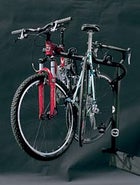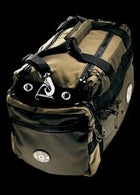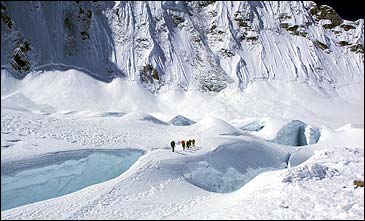(Nay)
I WAS IN A SEATTLE RESTAURANT a few years back when someone shouted, “Hands up, all who’ve climbed Everest!” Half the people at my table saluted, as did several patrons, the cook, and a busboy. With 1,922 ascents by the end of 2003, Everest is no longer an exclusive club. For the past six years, there’s been an average of 164 ascents per year; last spring, there were a record 264. On a single day last May, a whopping 118 people stood on the summit. Photos show a conga line of Gore-Tex’d, feather-suited Michelin men and women clipped to a rope, plodding in lockstep up the final ridge. That’s not climbing; it’s an aberration.
Everest climbing as it’s done today is so different from the rest of mountaineering that it’s become a subsport—call it Everesting. Everesting obviously isn’t about the solitude of the high peaks. Nor is it about breaking new ground: No routes have been established since 1996, when a Russian team blazed a trail up the northern side of the Northeast Ridge. The North Ridge and the Southeast Ridge are rope-strung highways, the perilous Khumbu Icefall tamed with ladders and ropes conveniently installed by Sherpas. The summit has become a stage for practically every special-interest group. It’s been said, lightheartedly, that the last summit achievement will involve that which is typically confined to the bedroom, between consenting adults.
I wouldn’t deny anyone their personal sense of fulfillment on the world’s highest point—it’s definitely a cool place to be—but I do think we’ve gone nuts over this peak. Everesting is overrated and overpriced, and it overuses the mountain.
Since I’m fool enough to thumb my nose at the Big E and incur the wrath of its fans, I should come clean on my prior relationship with the place. Herewith, I confess that I climbed Everest’s North Ridge, with oxygen, in 1995 to make the 736th ascent, and that I pulled on any old bit of rope or ladder rung to reach the summit. I also confess that I enjoyed the climb, and that I still cherish the sense of cosmic smallness that accompanied the view from the top. I admit that I dumped my oxygen bottle on the mountain and pilfered some tiny rocks near the summit.
But even Everest lovers have to question the media’s unrelenting fascination with the mountain, when its newsworthiness is completely played out. Everest isn’t the hardest, the most beautiful, or the only mountain, yet it gets all the attention, and the bloviated coverage lavished on it leads to a lopsided view of mountaineering. This creates a strange, unjust state of affairs for those talented black-belt alpinists who spend their lives making visionary ascents in the great ranges, on mountains other than Everest—K2, Lhotse, Annapurna, Gasherbrum IV, the Ogre, or the big walls of the Trango Towers. Those climbers get little recognition, while any Joe Blow who paid his way onto a guided ascent of Everest appears on talk shows, writes books, and becomes a motivational speaker.
EVEREST WASN’T ALWAYS OVERRATED. Not in 1924, when George Mallory and Sandy Irvine were pushing to the bitter end on the North Ridge in tweed jackets and hobnail boots, or in 1952, when the Swiss missed the summit by a maddening 825 feet, or in 1953, when Edmund Hillary and Tenzing Norgay finally, as Hillary put it, “knocked the bastard off.” Try telling the three Chinese and Tibetan climbers who made the first ascent of the North Ridge, in 1960, that Everest is overrated, and Qu Yinhua will show you his amputated toes and tell you how he whipped off his boots and thick socks, above 28,000 feet, to climb the rocky Second Step.
Everest really meant something back then. In this laboratory for high-altitude alpinism, climbers proved that they could survive an ascent without oxygen (Reinhold Messner and Peter Habeler, in May 1978, via the Southeast Ridge), and that the peak could be climbed in winter (Poland’s Leszek Cichy and Krzysztof Wielicki, in February 1980, via the same route). But then, by the end of the eighties, Everest was climbed out. By 1992, when the first paying clients arrived and the mountain morphed from climbing challenge to $65,000-a-pop commercial enterprise, its mystique was lost. Examining the tables compiled by Himalayan chroniclers Xavier Eguskitza and Eberhard Jurgalski on the Web site ���ϳԹ���Stats.com, I calculated that about 1,000 ascents, roughly half of the total, have been made by clients and their guides. I’ve seen at least one client who’d never worn crampons make it up the North Ridge.
Just because I take the snide side in this argument doesn’t mean that I’m losing sleep because the door to a once rarefied adventure has opened to the masses. Nor do I begrudge the jobs that Everesting has created for Sherpas, guides, cooks, porters, and writers like me. What I am suggesting is that Everest could be saved from the insult of this whole debate if climbers would show some imagination and repeat something besides the Southeast and North ridges, the paths of all but a mere 133 Everest ascents. It wouldn’t be overrated to test your mettle on the 1979 Yugoslav Route, on the West Ridge, with its technical rock at 27,000 feet; or to try to match Swiss climbers Jean Troillet and Erhard Loretan’s 43-hour alpine-style speed ascent of the North Face’s Japanese Couloir, in 1986; or to make the second ascent of the terrifyingly steep 1982 Russian Route on the Southwest Pillar. Of course, it would mean embracing risk: The four Slovaks who repeated the 1975 British Route on the Southwest Face in 1988 were so exhausted that they couldn’t climb down. They’re still up there, somewhere.
That sort of brinkmanship isn’t for everyone, but the paucity of takers tells us what kind of Everesters we’ve become. Year in, year out, we retrace paths opened half a century ago, fixing ropes to the same anchors and camping on the same sites as Hillary et al. Long gone are the days when Everest was, well, Everest.
(Yea)
IT HAS BEEN SAID THAT, in 1923, George Mallory was asked one too many times why he wanted to climb Mount Everest, and that his famous reply—”Because it is there”—was snapped back in irritation. So now, 81 years later, what part of “Because it is there” is so hard to understand?
I like Mount Everest. I like climbing it (I’ve tried to get up the thing eight times now and have succeeded four), and I like helping other people climb it. I like to talk about climbing Everest, I like to write about it. Catch my modest slide show and you, too, can relive every glorious moment of my expeditions there.
What bothers me is the tendency among climbers who get their own sorry asses up Mount Everest only to spend the rest of their days preaching why you shouldn’t. “It was harder back then,” they say (most things were); “Our motives were purer” (and for the proper fee I can expound on just how pure); and “I was curious about my own limits” (and you should not be).
Admittedly, a day on Everest now can be easier than in days of yore. But on the easiest possible day—clad in space-age fabrics, sucking more oxygen than Jacques Cousteau, with a fixed rope in place—Everest is still hard enough for me. It is no simple thing to climb to 29,035 feet, and it never will be. Even so, mere mortals do make it to the top on occasion, which has fueled a strange debate. Some of the loudest critics are those climbers who believe that only first ascents and extreme difficulty are worth chasing after. But I believe there are other legitimate reasons to step into crampons. For one, I enjoy legendary, old ascents, and I get immense satisfaction tackling the same obstacles my heroes faced.
Yes, there are crowds on Everest most years now, and no doubt there will be again in May. Would I like to be the only person on the sacred Everest playing field? Yes. Is that going to happen? No. You might be surprised to learn that many of the people in the crowds are darn good folks. We’ve heard about the idiots on Everest so many times that it can appear as if unpleasantness is somehow a requirement for getting a permit. But great acts of bravery, kindness, and strength still occur on the mountain. If you can no longer sift through the media production to appreciate that a blind man climbed 29,035 feet above sea level, that’s your loss. If you missed the significance of the first ascent this past spring by an African black man, then maybe your view of climbing has too much to do with rocks and too little to do with humanity.
Many climbers argue that there’s no challenge or mystery left on Everest. But I’d take my hat off to anybody who managed an alpine-style retracing of Tom Hornbein and Willi Unsoeld’s 1963 West Ridge–to–Southeast Ridge traverse. Hell, I’d buy your book, watch your movie, and even purchase merchandise that you’d endorsed. If you then managed to climb a line directly up the North Face without relying on either of the prominent couloirs, I’d nominate you for a Nobel Prize. Put another line up the brutal Southwest Face and nobody will ever kick sand in your face again.
When potential Everest clients come my way, I don’t look down my nose at them. Climbing, to me, has always been about making good personal decisions. Choosing to be guided on Everest is not a violation of any sound climbing principle that I can think of. Even so, there’s widespread concern that people can now “buy their way” to the top. Yes, it takes a lot of money to make the climb, but that’s not new. Besides, in the old days, the money came from taxpayers and charity drives, while it now comes from the participants. Isn’t that an improvement?
I wouldn’t think of convincing you that climbers don’t have some negative impact on Everest’s fragile environment, but it’s important to keep things in perspective. All of us have a negative impact on fragile environments when we choose to visit them. In my experience, the commercial ventures have become caretakers of the mountain, watching out for Sherpas’ rights and hauling trash down. Continued interest in Everest has fueled a viable economy in the Khumbu region of Nepal. Certainly, the climbing Sherpas earn their living in a dangerous and difficult environment, but their compensation has been at the upper limits of what their countrymen could hope to receive.
Some spectators have the bizarre notion that Everest should be some sort of money-free zone, that a board made up of monks, old climbers, and historians should interview potential mountaineers to make sure they’re pure of heart. Although many wealthy people have come to Everest, it might be argued that those patrons who buy their way up may prove to be more effective advocates for preservation than climbers alone ever could. Ultimately, I wonder if the climbing world fully realizes that Everest is not our mountain. It belongs to the people of Nepal and Tibet, after all.
MY FIRST TIME ON EVEREST’S SUMMIT, in May 1994, didn’t feel either crowded or easy. I was alone in a snowstorm, destined to run out of oxygen and daylight before I could make progress downward. My next time up there, in 1999, wasn’t crowded, easy, or even pleasant, come to think of it. I was badly anemic and not enjoying having run out of oxygen. By the spring of 2000, I was back on top, alone in a snowstorm again.
In May 2003, my commercial team sat in tents at 26,000 feet on the 50th anniversary of Hillary and Norgay’s summit day. After two months of trying, we acknowledged that continued high winds would prevent a summit attempt. But late that evening, the winds stopped, and we began to climb. A spectacular sunrise gave a hint of warmth and a calm summit. By 7:45 a.m., my “crowd” of eight—four Sherpas, two guides, and two guided climbers—began gathering on top. I took great pride in showing my team this special place. Through tears of joy, we gazed out on a thousand beautiful peaks. Had Mallory seen such a view, “Because it is there” would surely have been modified to include profanity. When all is said and done, you can’t beat the view from the top of the world.
Gear of the Year
Sport Racks and Luggage


Sport Racks
Bauer Vehicle Gear Back Road II Pro $349
WHY IT RULES: Being on top isn’t always best. Here’s a rugged, functional, and—dare we say it?—elegant rack that totes gear behind your vehicle. » Finally, a hitch-mounted rack that doesn’t ask you to correctly sequence a half-dozen knobs when you want to get inside your car. Forget a water bottle in back? Spin a single lock—I did it with my foot—and watch the slightly angled, gas-assisted bar politely swing out of your way. » The two bike arms have soft rubber cradles and locking tabs on either side, making it easy to secure any top tube. They also accommodate funky frame shapes. » Once it’s loaded, an anti- wobble arm keeps up to four bikes from clanging around on rough roads. » The Back Road packs in loads of features—like an integrated cable-lock system—and the simple design works incredibly well. HMMM…The bike cradles are a bit narrow; be tender when loading steeds with dangling cables.
Luggage
Red Oxx PR5 Safari-Beano’s Bag $175
WHY IT RULES: The Red Oxx guys, former military parachute riggers, are as intolerant of weakness in their duffels as they were with their chutes. To wit, this 2,400-cubic-inch bag is built to extreme specs—the fabric is 1,000-denier Cordura, the titanium of the bag biz. The oversize webbed-nylon handles aren’t just double- box-stitched to the bag; they wrap around it. Overkill? Probably. But I’ll take it. » The zippers are the industry’s biggest, hence strongest. And the swiveling shoulder-strap clips—plus the V-rings they snap into—are stainless-steel sailboat hardware. » The contact section of the shoulder strap is slip-proof injection-molded rubber. » Beano is the nickname of an Oxx owner’s neighbor in Billings, Montana, who loves pockets, so this bag has ’em on all four sides of the main hold. HMMM…Though I wouldn’t trade it for plastic, that boat hardware is pretty clanky.



